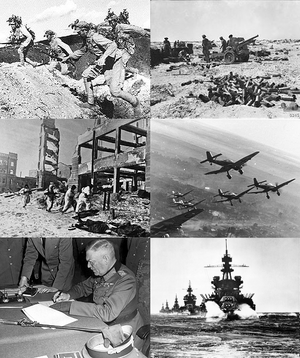Second Great War
This page is currently undergoing major reconstruction in accordance with broader lore changes. |
The Second Great War, also sometimes called the World War, was a global war that lasted from 1934 to 1943. The vast majority of the world's countries—including all of the Great Powers of the time - were involved. A state of total war emerged, directly involving more than 100 million people and resulting in over 64 million deaths. The major participants threw their entire economic, industrial, and scientific capabilities behind the war effort, blurring the distinction between civilian and military resources. It is marked by massive strategic bombing campaigns of industrial and civilian centers, trench warfare, the rise of mechanized warfare, and the only use of nuclear arms in war. It remains the deadliest conflict in human history.
| Second Great War | |||||||
|---|---|---|---|---|---|---|---|
 Clockwise from top left: Hekuvian nuclear bombing of Paulastra, Kiravian planes being reloaded after conducting missions in 1952, Umcaran paratroopers landing during the Invasion of Paulastra in 1949, Flordetian soldiers during the Siege of Marcus in 1951 | |||||||
| |||||||
| Belligerents | |||||||
|
| ||||||
| Commanders and leaders | |||||||
|
|
| ||||||
| Casualties and losses | |||||||
|
Military dead: over 26,000,000 Civilian dead: over 40,000,000 Total dead: over 56,000,000 |
Military dead: over 20,000,000 Civilian dead: over 28,000,000 Total dead: over 48,000,000 | ||||||
Background
Caphirian Expansionism
Beginning in the 17th century, Urcea and the Holy Levantine Empire began to directly confront Caphiria and worked proactively to prevent its spread into Levantia. The Levantine powers began intervene in various conflicts and international incidents on Sarpedon, which Venceia had long considered its prerogative. In the Veltorine War of Independence in the 1770s and 1780s, Urcea on behalf of the Holy Levantine Empire intervened, aiding the eastern provinces of Caphiria in their quest to secede. Not only did Caphiria lose that war, losing much of its eastern territory to the new nation of Veltorina, but Urcea gained the new Kingdom of Talionia, giving the Levantines a toehold in Urlazio. Out of these developments, the conspiracy theory of Levantine Creep developed - and Caphirian policymakers were determined to make any moves necessary to disrupt and dislodge the Levantine powers, actions it claimed to take in self defense.
The independence of Veltorina was considered a grave affront to the prestige and independence of Caphiria, but with guarantees on its independence from members of the Holy Levantine Empire, Caphiria was unwilling to take on the Empire by itself. Throughout the 19th century, Caphiria made contact with agitators and rebels throughout the Empire and especially within Dericania. Famously, 1848 revolutionaries in Dericania following the Second Caroline War refused to accept Caphirian assistance, hoping to curry favor with the Emperor of the Levantines, a strategy that failed. Caphirian concerns with Veltorina were escalated dramatically with the Tyrian Revolution in 1864, which turned its eastern neighbor into a socialist state. Despite this development, the Levantines refused to abandon Veltorina. Caphirian policymakers began to develop a long-term plan on how to proceed, and would spend the next several decades waiting for an opening.
First Great War
The Ten Year Plan
Levantine Theater
Sarpedonian Theater
Initial Caphirian successes
War at Sea
Invasion of Vespera
Cavosia and end of the war
Cronan Theater
Intervention in the Cape
Operation Forefront
War in the Orixtal
TBA
Eastern Theater
Nationalist agitation
Formation of the League and initial League campaigns
Burgoignesc Campaigns in Alshar and Audonia
War in the Cathay
TBA